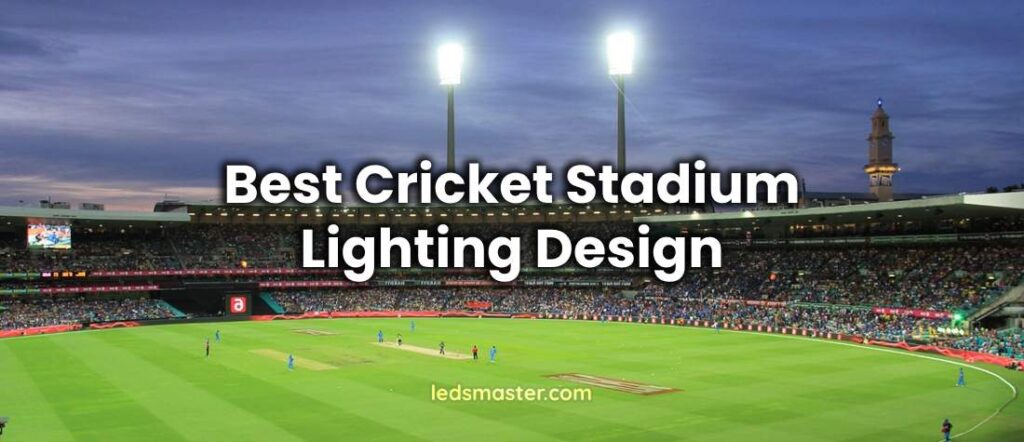We provide comprehensive lighting solutions for cricket fields and stadiums, specializing in high-performance LED systems. LEDs are the superior choice for replacing traditional halogen, mercury, and metal halide lights due to their superior brightness, energy efficiency, and durability. For professional cricket grounds, the lighting requirements can range between 50,000 to 80,000 watts, with an estimated cost of approximately $75,000 to $100,000.
Effective lighting design is crucial for ensuring optimal visibility for players, spectators, and officials. Typically, cricket stadium lighting is arranged to encircle the circular turf, requiring high-power, long-distance high mast LEDs to achieve uniform illumination across the field. As a manufacturer, we offer affordable outdoor flood lights specifically designed for cricket grounds, helping you reduce overall costs while maintaining high-quality performance.
Table of Contents
ToggleLighting Requirements for Cricket Grounds
Cricket grounds have distinct lighting needs that vary based on the level of play and the specific type of stadium. To ensure optimal performance and visibility, it is essential to understand the varying lux levels required for different settings.
Lux Level (Brightness) Requirements
The illumination requirements for cricket fields differ significantly depending on the level of competition. For general practice and recreational matches, a lux level ranging from 250 to 350 is usually sufficient. This level of brightness provides adequate visibility for players to engage in casual competition and practice sessions. It ensures that the lighting is bright enough to support gameplay without being excessively intense.
In contrast, professional matches demand higher levels of illumination due to the increased activity and movement on the field. For these matches, a lux level of 500 to 750 is recommended. This higher brightness is crucial as it accommodates the more dynamic nature of the game, allowing players to perform at their best. Enhanced lighting in professional settings not only improves player visibility but also contributes to better overall performance.
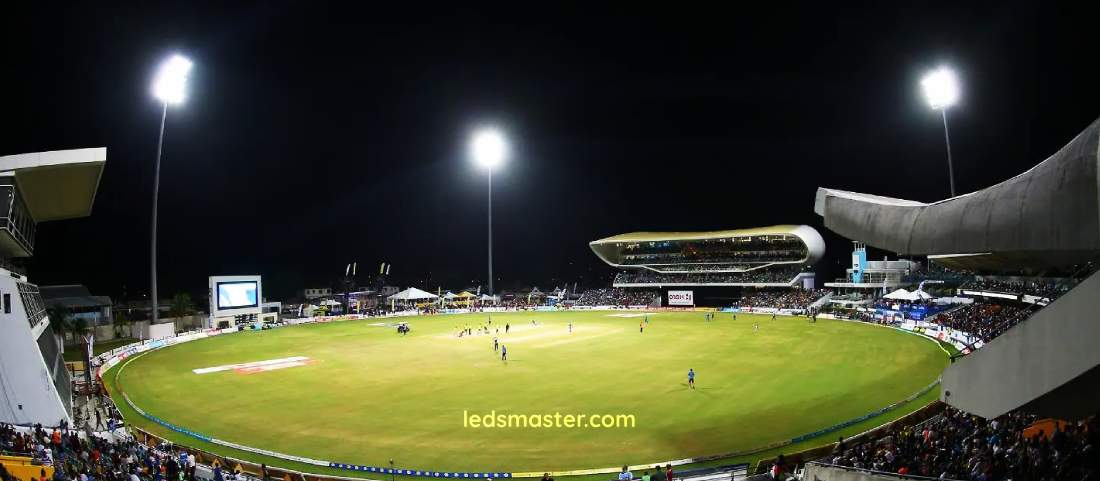
For international tournaments and high-profile events, the lighting requirements are even more stringent. Stadiums hosting such events require a lux level between 1,500 and 2,500. This high level of brightness is essential for clear and detailed photo and video capture, meeting the standards necessary for global broadcasting and media coverage. The increased illumination ensures that every detail is visible, providing a professional standard of lighting for international audiences.
Total Power Required for Cricket Field Lighting
Calculating the total power needed for cricket field lighting involves understanding the size of the field and the desired lux level. For a typical cricket field with a radius of approximately 70 meters, the total area is about 15,400 square meters.
To illustrate, if we consider the lighting requirement for professional matches, which is 750 lux, the total lumens needed can be calculated as follows: 15,400 square meters multiplied by 750 lux results in 11,550,000 lumens. Given that our LED lights produce 140 lumens per watt, the minimum power required is calculated by dividing the total lumens by the lumens per watt, resulting in approximately 82,500 watts.
This calculation provides a preliminary estimate of the power required. For a more accurate and customized lighting design tailored to specific needs, consulting with our engineers is highly recommended. They can provide a professional assessment and ensure that the lighting system meets all requirements and standards.
Lighting Design for Cricket Stadiums
To effectively secure cricket ground lighting tenders, it is crucial to have a precise and well-presented photometric analysis. LedsMaster has over 12 years of experience in managing sports and stadium lighting projects, including those for football, rugby, tennis, and badminton.
A thorough photometric analysis typically includes detailed visual representations, such as false color renderings and value charts. For example, a comprehensive lighting design might show a lux level distribution where the majority of the field reaches up to 2,625 lux. This level of illumination is suitable for international tournaments, as indicated by the value chart, which shows lux levels ranging between 2,000 and 3,000. Such detailed analysis ensures that the lighting design meets the high standards required for professional sports fields.
If you are interested in obtaining a detailed lighting analysis report for your cricket field project, please feel free to reach out to us. Our team is ready to assist you in achieving the optimal lighting design for your specific needs.
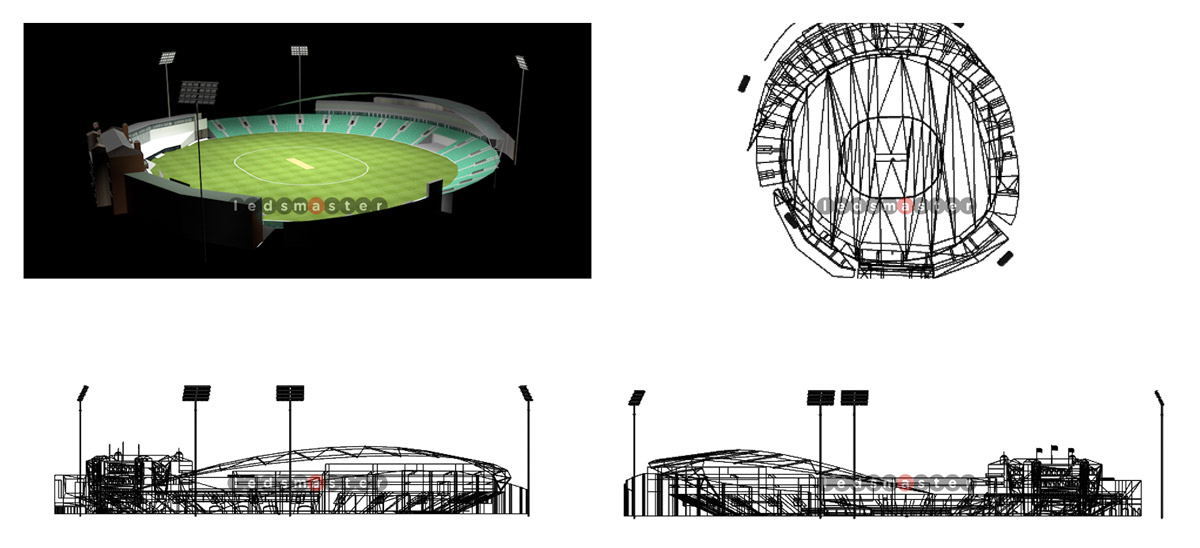
Advanced LED Solutions for Cricket Field Lighting
Our LED lighting solutions for cricket fields are engineered to deliver outstanding performance and energy efficiency. Each of our LED cricket lights features advanced 15W LED chips with an impressive luminous efficiency of 160 lumens per watt. This is a significant improvement over traditional metal halide (MH) lamps, which typically offer around 70 lumens per watt. This enhanced efficiency results in energy savings of at least 75%, substantially reducing both energy consumption and electricity costs.
Our LEDs are designed to produce a focused beam of light, ensuring optimal illumination on the cricket turf. We meticulously adjust the optical design to meet the specific needs of each installation, considering factors such as power, beam angle, and anti-glare features. This tailored approach ensures that every cricket field benefits from precise and effective lighting.
Lighting for Indoor Cricket Courts
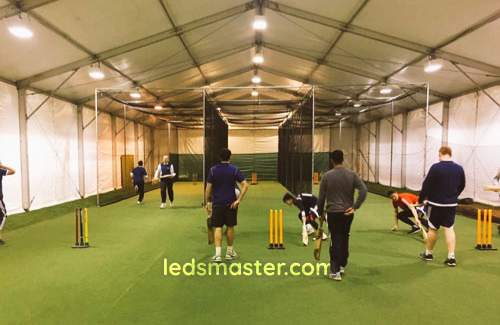 We also offer specialized lighting solutions for indoor cricket courts. Managing heat is a critical concern for indoor lighting systems. As luminaires operate, they generate heat, which can damage internal electronics if not properly managed. To address this, we have developed a sophisticated thermal management system. Our lights feature extensive heat sinks with a large surface area to efficiently dissipate heat, thereby protecting the internal components and ensuring longevity.
We also offer specialized lighting solutions for indoor cricket courts. Managing heat is a critical concern for indoor lighting systems. As luminaires operate, they generate heat, which can damage internal electronics if not properly managed. To address this, we have developed a sophisticated thermal management system. Our lights feature extensive heat sinks with a large surface area to efficiently dissipate heat, thereby protecting the internal components and ensuring longevity.
Anti-Glare and Flicker-Free Lighting for Televised Cricket Fields
For high-profile outdoor stadiums, such as those hosting international tournaments like the ICC Cricket World Cup, our lighting systems meet the highest standards for flicker-free illumination. Our LED fixtures are capable of supporting filming frequencies between 5,000 and 6,000 Hz with a flicker rate of less than 0.3%. This ensures stable lighting and consistent lumen output during broadcasts. Additionally, our anti-glare technology reduces the dazzling effects on players and spectators, minimizing light trespass and pollution while enhancing the overall viewing experience.
Improved Lighting Uniformity
Uniform lighting is essential for both player performance and spectator comfort. Inconsistent brightness can cause visual discomfort and disrupt gameplay. Our top-tier optical design ensures a uniformity value of 0.8, fulfilling the standards required by organizations such as the USACA. The low-glare optics of our fixtures are particularly advantageous in large stadiums, accommodating thousands of spectators without causing eye strain. Furthermore, our optics support high-speed photography up to 5,000 Hz, making them ideal for capturing fast-paced action without distortion.
Modular Design for Easy Maintenance
Our LED cricket stadium lights are designed with a modular approach to facilitate easy maintenance. In the event of a malfunction—whether due to wiring issues or external factors like natural disasters—damaged components can be quickly replaced without the need to replace the entire fixture. This modular design allows for rapid repairs, significantly reducing maintenance time and costs. We provide free modular units for installation, making the repair process both efficient and cost-effective.
Running Costs of Cricket Stadium Lighting
Switching to LED technology can lead to substantial savings in operating costs. For a cricket field requiring a lux level of 750 and a total power of 82,500 watts, the daily running cost of LED lighting is approximately $79.20, based on an 8-hour usage at $0.12 per kWh. Over a month, this amounts to around $1,740 (assuming 22 days of use). In comparison, traditional halogen lights would result in a monthly electricity bill of approximately $17,400 due to their much lower energy efficiency. By adopting LED lighting, you can achieve significant cost savings while benefiting from superior performance and durability.
Cricket Field Lighting: Common Questions and Answers
Do Floodlights in Cricket Grounds Consume a Lot of Electricity?
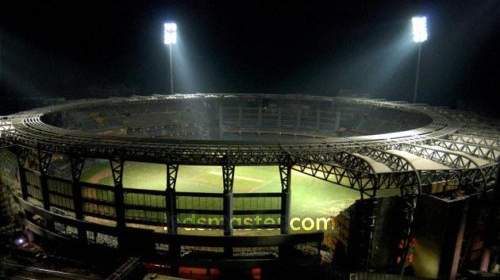 A common concern among stadium owners is the electricity cost associated with cricket field lighting. Replacing outdated lighting fixtures with modern LED solutions can significantly reduce these costs. Compared to metal halide, halogen, and mercury vapor lights, LED floodlights are much more energy-efficient.
A common concern among stadium owners is the electricity cost associated with cricket field lighting. Replacing outdated lighting fixtures with modern LED solutions can significantly reduce these costs. Compared to metal halide, halogen, and mercury vapor lights, LED floodlights are much more energy-efficient.
Our LED lights offer a luminous efficiency of 160 lumens per watt, which is twice as efficient as traditional high-intensity discharge (HID) lights and ten times more efficient than halogen floodlights. For example, a 1,000-watt LED light provides a similar amount of illumination as a 10,000-watt halogen flood lamp.
In addition to their lower power consumption, LEDs produce significantly less heat compared to traditional lighting options. Excessive heat from high-power lights can make the environment uncomfortable for players and spectators, impacting the overall experience. Halogen bulbs, for instance, convert nearly 95% of their energy into heat, making the cricket pitch uncomfortably hot. In contrast, LEDs waste only about 5% of their energy as heat, offering a cooler and more efficient lighting solution.
How Long Do the Floodlights Last?
When considering a lighting upgrade for a cricket stadium, longevity is an important factor. LED floodlights offer a much longer lifespan compared to traditional lighting options, which can reduce both replacement and maintenance costs. Our LED floodlights have an impressive lifespan of approximately 120,000 hours. This translates to around 54.8 years if the lights are used for 6 hours per day.
In comparison, halogen lights typically last between 1,000 and 2,000 hours, while metal halide lamps have a lifespan of around 5,000 to 10,000 hours. The extended life of LEDs reduces the frequency of replacements and the associated maintenance costs, making them a cost-effective long-term solution.
How Much Does It Cost to Keep Stadium Lights On All Day?
The operational cost of stadium lighting can vary significantly depending on the type of luminaires used. For metal halide lights, with a total power consumption of around 400,000 watts, the cost to operate them continuously for 24 hours is approximately $1,152. In contrast, halogen floodlights, which consume around 1,000,000 watts, would cost about $2,880 for the same period due to their lower energy efficiency.
When using LED lights, the cost is considerably lower. For example, a 100,000-watt LED system, which is equivalent in brightness to 400,000 watts of halogen or 1,000,000 watts of HID lights, would cost around $288 to operate for 24 hours. The substantial difference in running costs highlights the financial benefits of switching to LED technology. By upgrading to LED lighting, you can achieve significant savings while maintaining optimal illumination for your cricket field.
Can LED Lights Be Used for Both Day and Night Matches?
Yes, LED lights are versatile and can be used for both day and night cricket matches. During the day, while natural light is predominant, LED lights can provide supplemental illumination to ensure consistent visibility and highlight any areas that need additional light. At night, LEDs offer full illumination, maintaining the high standards required for professional cricket matches.
LEDs are also adaptable to various lighting conditions. They can be dimmed or adjusted as needed to match different times of day or weather conditions, ensuring optimal lighting for all scenarios. This flexibility makes them an excellent choice for cricket fields that host matches at different times and under varying light conditions.
Conclusion
Our advanced LED lighting solutions offer superior brightness, energy efficiency, and durability for cricket fields and stadiums. With requirements ranging from 50,000 to 80,000 watts and costs between $75,000 to $100,000, LED lights provide significant savings compared to traditional options. They ensure optimal visibility for players and spectators, reduce energy consumption, and lower maintenance costs. Our tailored lighting designs, including advanced optics and modular features, deliver outstanding performance for any cricket venue. For customized lighting solutions, our team is ready to help you achieve the perfect setup for your cricket field.

